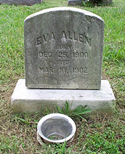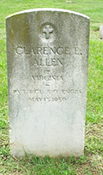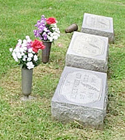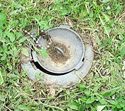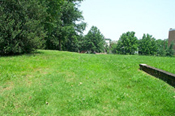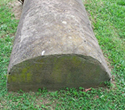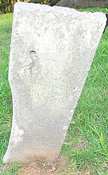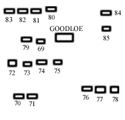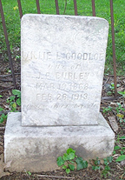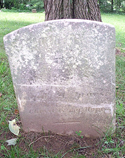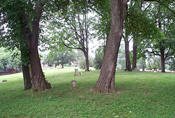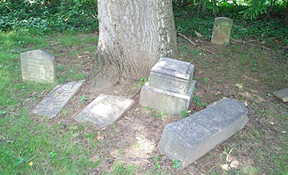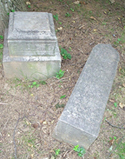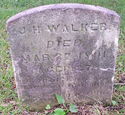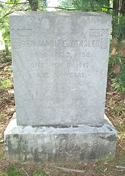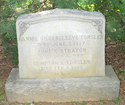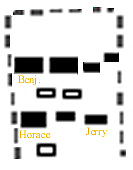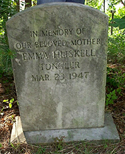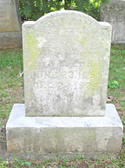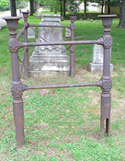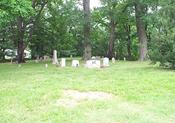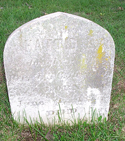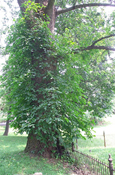Walking Tour: Daughters of Zion Cemetery
Although the stone does not explicitly list the age at death, the two girls died at age 6 and 2, respectively. Annie's date of death is the earliest in the cemetery, suggesting that this is the earliest stone. The other, more likely, possibility is that the stone was not erected until Hattie died in 1881 (it would have been difficult to carve the additional lines if the stone was already set in place). If this hypothesis is true, it would no longer be the first stone, but it is still one of the earliest stones erected in the cemetery. Today it is precariously placed at the edge of the cemetery, just before the ground slopes down to Oak street. Other Buckner family members are buried alongside these two girls.
Both stones are made of marble, but one stands vertically and the other is flush with the ground. Stone 173 lies opposite and to the east of stone 170.
It is possible that the two women mentioned on the markers (Ella Smith and Bea. Gaines) split the cost of the head and the footstone, with stone 173 representing the latter. Conversely, each woman wanted to show their respects separately. It is interesting that William is listed as the son of Addie Golden Coles but no father is listed. Moreover, it would appear as if William, who died at age 56, was not married, raising questions as to who the two women were who paid for separate monuments.
Other Stones in the Coles/Golden Plot
This plot is also interesting because it is dominated by relations among women. On either side of William are his mother (Addie, stone #172) and his aunt (Lula Jean, stone #169). Neither woman lists a husband (Lula was probably single at her death because she retains her maiden name, Golden). It is somewhat unusual for an adult male (William) to be listed as the "son of" his mother (especially leaving out the father's name). Similarly, although it appears that Addie's daughter, Hattie, was married (to Mr. Montague), the husband's name is not listed for either woman. Moreover, both of the people who erected monuments to William were women. And finally, the stone between William and Addie & Hattie (stone #171) commemorates another woman, Jenetta Dabney (died 1891). At present the relationship between Ms. Dabney and the Golden/Coles family is unclear.

Delia Johnston (1785-1895) Delia's stone reads: "Delia Johnston / wife of / Phillip Johnston / Born / Jun. 15, 1795 / Died / Nov. 23, 1895
In contrast to the blocky granite and marble markers seen at the last stop (stop 2), these tablet-style, marble markers represent an earlier tradition. Phillip's stone is one of the earliest in the cemetery. These two, roughly identical, markers represent a classic 19th Century pattern: tabular, curved markers with few or no symbols and husbands and wives buried alongside each other, very often with the woman listed as the "wife of." Note, Delia was a centenarian and was born in the 18th Century. Delia was 18 years older than Phillip, raising the possibility that this was her second husband (possibly she outlived the first, as well as the second one). It does not appear that any of their offspring (if there were any) or other kinfolk were buried in this cemetery. This raises an interesting question as to where their families were buried or, conversely, why they choose to be buried here.

Stone 142 reads: "Jane Coles / Born / Mar. ... 1845 / Died Feb. .... 1887 / In Memory of a faithful.... "
This plot, containing only two visible (or preserved) gravestones, is one of the more elaborate in the cemetery. The plot is raised above ground level and surrounded by a low, concrete wall. In addition, it is centrally positioned as one of the first plots if you enter the cemetery via the original entrance (referred to as the "alley" in historic documents). Although the kinship relationship between Jane and Jesse is, at present, uncertain, we do know that Jesse was born in 1821 while Jane was born in 1845 (suggesting that they were father/daughter). Jesse Coles was one of the original trustees of the cemetery. He is listed in several land deeds concerning the founding of the cemetery in 1873. This is, perhaps, the reason why he was able to select such an advantageous location within the cemetery.

As you visit this stop, notice the "A" set in a small square in the SW corner. This is not a gravestone, but rather a place marker for the family plot. Presumably there were once three additional markers in the other corners. This plots contains a range of gravestone styles, from blocky marble ones, to upright, blocky granite ones, to low-lying granite markers. The latter are a more recent marker style designed, in part, to create cemetery landscapes that resemble parks with less visually intrusive reminders of death.
Fifteen individuals are buried within this plot (stone 160 is the footstone that accompanies stone 159, while stone 154 commemorates two people).
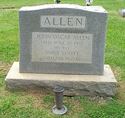
In contrast to the above, individualized marble markers, John and Anna's gravestone is made of granite and two people share one stone. In an oft repeated style, the husband is listed first, followed by the wife, with an explicit reference to her social role as "his wife." In a 20thC modification of the "footstone" the initials of each person are listed on lower edge of the monument, suggesting that John lies to the left, while Anna ("A.S.A.") lies to the right. The disadvantage (especially for genealogists) to this type of commemoration is that it only lists the date of death, making it impossible to reconstruct the age or birth date of the deceased. Note that Anna outlived her husband by 23 years, an unfortunate, but fairly common occurrence in the first part of the 20th Century. The container in front of the grave is for flowers.

Stone #92 is in the foreground, the two readable stones in the background belong to Louie L. Whitlock (on right) and Genevieve B. Hendersen (on the left). At present the relationship between those two individuals is unclear. This may be a lot set aside for single burials (as opposed to larger, family plots).
The Goodloe Family purchased four plots to make for a total of approximately 1600 square feet. The entire plot is surrounded by an iron fence (falling down in parts, but, originally, the gate would have linked the two front pieces). In a different pattern than most other plots in the cemetery, the Goodloe's choose squat, rectangular markers for each individual (similar in form to a footstone, but in this case, they serve as headstones). The standing granite marker reads "Goodloe" but does not list an individual. It would appear as if the upright marker commemorates the Family, while smaller stones commemorate each individual. Because these smaller stones do not contain biographical information (or last names) it is not possible to establish conclusively the relations among the deceased.
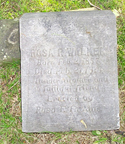
Rosa Walker (died 1918 at age 62) and (R) her husband, J.H. Walker (died 1891 at age 27). Rosa lived as a widow for 27 years. Rosa's marker was erected by Rosa E. Fagans (possibly a married daughter), while Mr. Walker's stone states that is was erected by "his wife." Rosa Walker's inscription reads "A tender mother and a faithful friend."
Both Burkley and his wife, Mary, were born into slavery. There gravestones are both carved from marble in a tabular form. Burkley's stone lacks any motif but Mary's contain a blooming flower (perhaps a rose). In the 19th C, flowers and buds are occasionally used to commemorate women or children.
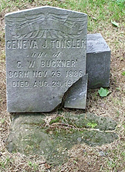
Geneva Tonsler (1886-1918) is not buried in the Tonsler Plot (see Tour 13) , but rather in the Buckner Plot (her husband's family). She was only 32 years old when she died. Her stone includes an interesting motif, a series of wings and a scroll. Also of interest is a second stone, lying underneath the marble marker. It is tempting to suggest that this lower stone was used as a place holder for the grave until (or possible before) the completion of the carved marker. There are several other examples of this practice in the cemetery.
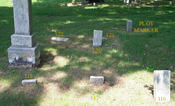
All but two of the stones in this plot (121 and 122) are footstones indicating the placement of the individuals who are memorialized on the standing obelisk. Six people are identified on the obelisk. All but two have separate footstones with their initials. The two individuals who lack footstones (but who are commem- orated on the obelisk) are "the children of C.E. Coles," Maggie M. (1886-1888) and Maud D. (1892-1902). It is not clear where "C.E. Coles" is buried or who his wife was. In addition to members of the Coles and Lewis family, two members of the Jones' Family are buried here. Presumably Rosa's maiden name was Coles.
| Stone | Footstone Inscription / Individual Buried (Date birth - Date death) |
|---|---|
| 116 | "R.C." — Rebekah Coles (1875 - 1876) |
| 117 | "J.C." — John L. Coles (1837-1905) |
| 118 | "P.C." — Perciller Coles (1844-1912) |
| 120 | "F.L." — Fountain Lewis (1818 - 1898) |
| 121 | William H. Jones (1860-1917) |
| 122 | Rosa Jones ( ? - 1929) |
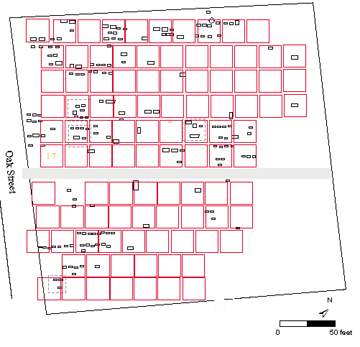 This plot no longer contains any visible gravestones, but an early deed suggests that Tamar Wright and her heirs once owned the lot.
This plot no longer contains any visible gravestones, but an early deed suggests that Tamar Wright and her heirs once owned the lot.
In the Zion Cemetery Deed Book #10 the Clerk (S.J. Ferguson) recorded the purchase of a lot by Tamar Wright for $1.25 in 1899. The deed describes the lot as "a certain half section, on the south side of the Charlottesvilles Section in Church Hill Cemetery of the Daughters of Zion of said city, fronting 9 feet and running back 18 feet." The map pictured below demonstrates a hypothetical reconstruction of the division of plots based on this description and, presuming, that "whole" sections were roughly 18 x 20 feet (this is based on a second deed) and that when individuals were buried singlely, they were still placed within existing (albeit imaginary) boundaries.
The estimated location of Tamar Wright's plot is indicated by the number "17."
The lack of standing gravestones in this area may be due to several reasons: no markers were ever placed, the markers were made of wood or a similar material that did not preserve, or the markers have sunken into the ground and are just below the surface.

Granite monument, Artie Ward (1875-1966) and Nancy Smith (1890-1946).
This monument has a husband and wife, sharing a headstone. The floral motifs suggest a garden and/or the regeneration of life. The marker itself is also "naturalized" with a deliberately "hewn" look added to the otherwise smooth granite.
Granville was Emma's father. The fact that Emma is buried next to her father and there is no mention of a spouse, suggests that Emma died unmarried at age 50. Both of these markers are very blocky and, especially in the case of Emma, are designed to resemble "houses of thea dead." The association of graves with houses (or, often, beds) connotes eternal rest.











